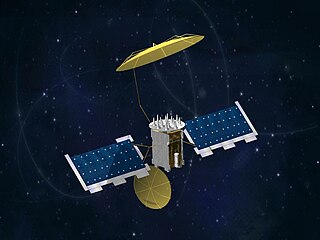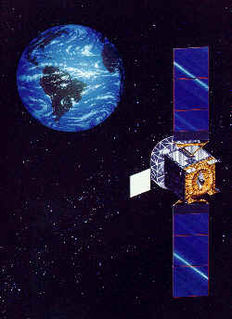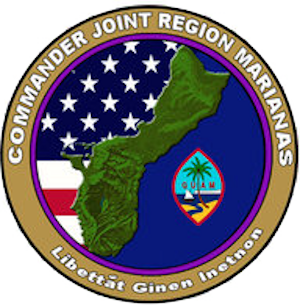
Guam is an organized, unincorporated territory of the United States in the Micronesia subregion of the western Pacific Ocean. It is the westernmost point and territory of the United States ; in Oceania, it is the largest and southernmost of the Mariana Islands and the largest island in Micronesia. Guam's capital is Hagåtña, and the most populous village is Dededo.

The U.S. Tracking and Data Relay Satellite System (TDRSS) is a network of American communications satellites and ground stations used by NASA for space communications. The system was designed to replace an existing network of ground stations that had supported all of NASA's manned flight missions. The prime design goal was to increase the time spacecraft were in communication with the ground and improve the amount of data that could be transferred. Many Tracking and Data Relay Satellites were launched in the 1980s and 1990s with the Space Shuttle and made use of the Inertial Upper Stage, a two-stage solid rocket booster developed for the shuttle. Other TDRS were launched by Atlas IIa and Atlas V rockets.

The Mobile User Objective System (MUOS) is an United States narrowband military communications satellite system that supports a worldwide, multi-service population of users in the ultra high frequency (UHF) band. The system provides increased communications capabilities to newer, smaller terminals while still supporting interoperability with legacy terminals. MUOS is designed to support users who require greater mobility, higher bit rates and improved operational availability. The MUOS was declared fully operational for use in 2019.

Naval Computer and Telecommunications Area Master Station Pacific provides operational direction and management to all Pacific Naval Telecommunication System users. In addition to this function, NCTAMSPAC manages, operates, and maintains Defense Communication System and Naval Telecommunication System assets, and offers a full range of ADP and information resource services, maintenance and repair, and communication/electronic and Defense Message System coordination to the United States Navy and other United States Department of Defense (DoD) activities in the Pacific.

Ultra High Frequency Follow-On (UFO) satellite system is a United States Department of Defense (DoD) program sponsored and operated by the United States Navy to provide communications for airborne, ship, submarine and ground forces. The UFO constellation replaced the U.S. DoD Fleet Satellite Communications System (FLTSATCOM) constellation and consisted of eleven satellites. The ground terminal segment consists of equipment and resident personnel at existing satellite communication stations. The satellites are controlled by the Naval Satellite Operations Center (NAVSOC) located at the Naval Base Ventura County, Point Mugu, California.

Naval Network Warfare Command (NETWARCOM) is the United States Navy's information operations, intelligence, networks and space unit. Naval Network Warfare Command's mission is to execute, under Commander TENTH Fleet Operational Control, tactical-level command and control of Navy Networks and to leverage Joint Space Capabilities for Navy and Joint Operations.
The Naval Computer and Telecommunications Station Naples provides voice, video and data services to the U.S. Navy joint, allied and coalition customers. It has two manned sites: C4I at Capodichino and SATCOM at Lago Patria. NCTS Naples has approximately 20 Officers, 325 Enlisted personnel, and 40 civilians.

Naval Base Guam is a strategic U.S. naval base located on Apra Harbor and occupying the Orote Peninsula. In 2009, it was combined with Andersen Air Force Base, to form Joint Region Marianas, which is a Navy-controlled joint base.

The Orote Peninsula is a four kilometer-long peninsula jutting from the west coast of the United States territory of Guam. A major geologic feature of the island, it forms the southern coast of Apra Harbor and the northern coast of Agat Bay. Its tip, Point Udall, is Guam's westernmost point and also the United States' westernmost point by travel, not longitude. The peninsula historically was the site of the important Chamorro village of Sumay, as well as Fort Santiago of the Spanish colonial period. In modern times, the peninsula is politically in the village of Santa Rita, but it is controlled in its entirety by Naval Base Guam.
The Naval Computer and Telecommunications Station (NCTS) Far East is a Navy military unit headquartered in Yokosuka, Japan. The unit consists of nine geographically-dispersed sites in Japan, South Korea, Singapore, and Diego Garcia. NCTS Far East's mission is to "operate and defend mission critical, Navy warfighting networks and communications systems necessary for U.S. Naval, Joint, and Coalition Commanders to conduct secure command and control in the U.S. Indo-Pacific Command (USINDOPACOM) theater of operations."

Joint Region Marianas (JRM) is a U.S. Navy-commanded joint military command. JRM is the installation management authority for all United States Department of Defense installations on Guam and the Northern Mariana Islands. This includes Andersen Air Force Base (AFB), Naval Base (NB) Guam, and Marine Corps Base (MCB) Camp Blaz. Its headquarters is located in Nimitz Hill Annex, Asan-Maina, Guam. The command is an amalgamation of the United States Navy's NB Guam and United States Air Force's Andersen AFB, which were merged on October 1, 2009.

Dededo is the most populated village in the United States territory of Guam. According to the U.S. Census Bureau, Dededo's population was just under 45,000 in 2010. The village is located on the coral plateau of Northern Guam. The greater Dededo-Machanao-Apotgan Urban Cluster had a population of 139,825 as of the 2010 census, making up 87.7% of Guam's population and 29.8% of its area.
Naval Radio Transmitter Facility LaMoure is a United States Navy installation located about 3 km west of LaMoure, North Dakota. The site uses a former OMEGA Navigation System station as a VLF transmitter for communications with the US submarine fleet. Commander Blake Wayne Van Leer lead the construction and opening of the site.

Naval Radio Transmitter Facility Niscemi is a transmission facility of the United States Navy at Niscemi, Sicily, maintained by the N92 Division of Naval Computer and Telecommunications Station Sicily. The facility houses low frequency (LF) and high frequency (HF) transmitter and antenna systems, and certification of the new U.S. Navy Mobile User Objective System (MUOS) ground terminals is in progress as of early 2015.

The Haputo Beach Site is a prehistoric village site in northwestern Guam. The site, located on Naval Computer and Telecommunications Station Guam land near a sheltered cove, includes standing latte stones, as well as rock shelters and caves with evidence of human occupation. In addition to needing military permission for access to the site, the main trail leads through the Navy's Haputo Ecological Preserve.

Marine Corps Base (MCB) Camp Blaz is a U.S. Marine Corps facility located in the village of Dededo in northwest Guam. MCB Camp Blaz was activated on October 1, 2020, becoming the first new Marine Corps facility since the predecessor of Marine Corps Logistics Base Albany was commissioned on March 1, 1952. The base will house Marines relocated from installations in Okinawa Prefecture, Japan, with the final relocation planned for 2025. Joint Region Marianas is the installation management authority for MCB Camp Blaz, as well as Naval Base Guam and Andersen Air Force Base.

Sumay, also Sumai, was a village on the United States territory of Guam. It was located on the north coast of the Orote Peninsula along Apra Harbor. It was inhabited by Chamorro people before contact with Europeans. Sumay became a prosperous port town serving whalers and other sailors in the 1800s and the second most populous settlement on Guam after Hagåtña, the capital of the Spanish Mariana Islands. Following the Capture of Guam by the United States in 1898, the village was the site of Marine Barracks Guam. In the early 1900s, it was a link for two firsts connecting the United States and Asia: the first submarine communications cable for telegraph and the China Clipper, the first air service. After the Japanese invasion of Guam in 1941, the residents were evicted and the village turned into a Japanese military garrison. Sumay was leveled during the U.S. liberation of the island in 1944. The U.S. military prohibited the residents from returning, relocating them to the hills of nearby Santa Rita. In 1948, the U.S. military exercised eminent domain and took all private and commercial property at Sumay. Its former location is now on Naval Base Guam.

Radio Barrigada, formally Communications Site Barrigada and previously Communications Annex Barrigada, refers to two adjacent U.S. military transmitter facilities located in the villages of Barrigada and Mangilao on the western Pacific territory of Guam. The larger facility is Naval Computer and Telecommunications Site (NCTS) Barrigada, operated by Naval Base Guam, located entirely within Barrigada. To its south, the Barrigada Transmitter Site, operated by Andersen Air Force Base, lies partially within Mangilao. The installation itself is managed by Joint Region Marianas. Radio Barrigada is the counterpart to the telecommunications receiving site Naval Computer and Telecommunications Station Guam, located to the north in Finegayan, Dededo. Located near the high point of Mount Barrigada, Radio Barrigada comprises 1,800 acres (7.3 km2).














